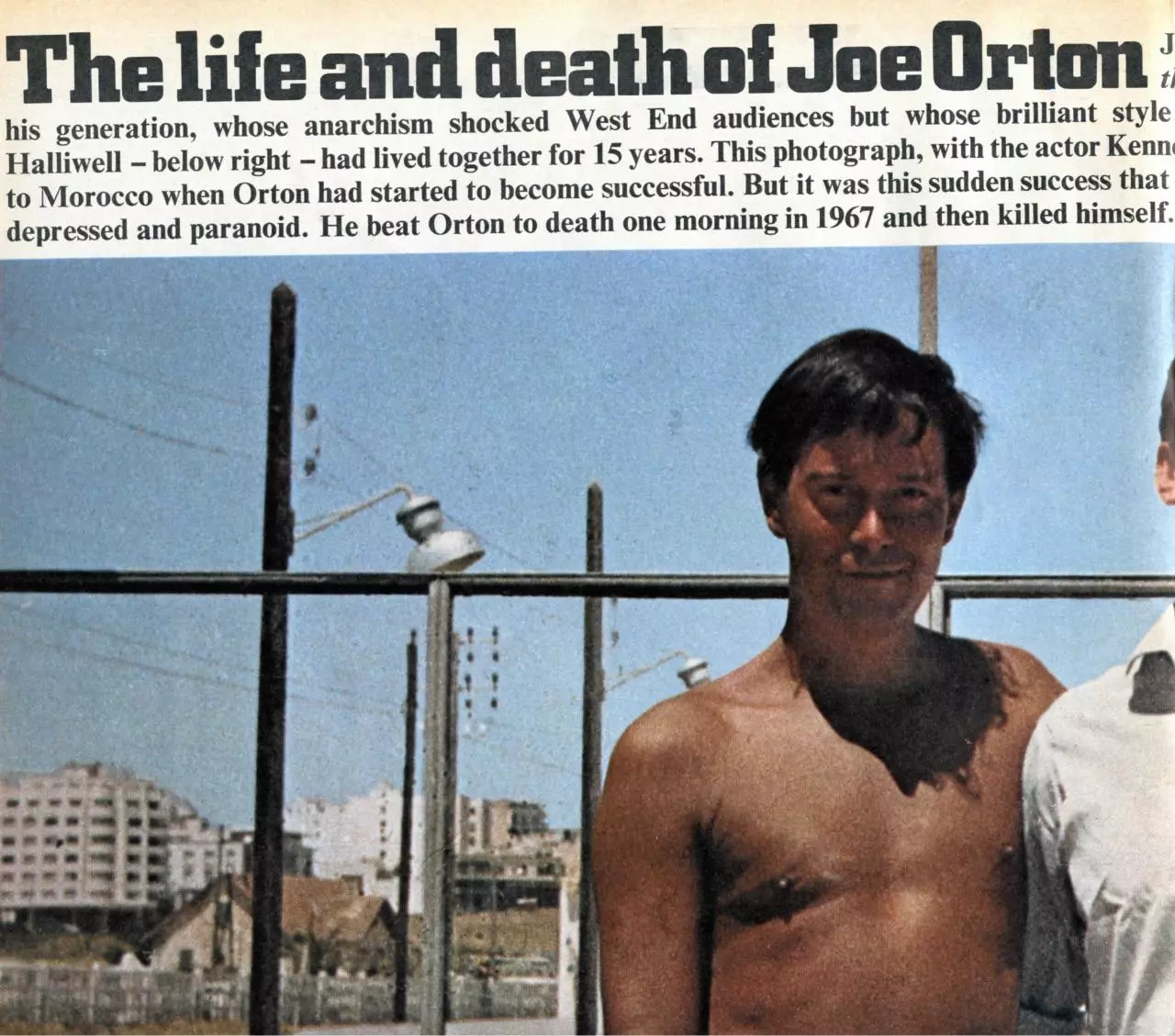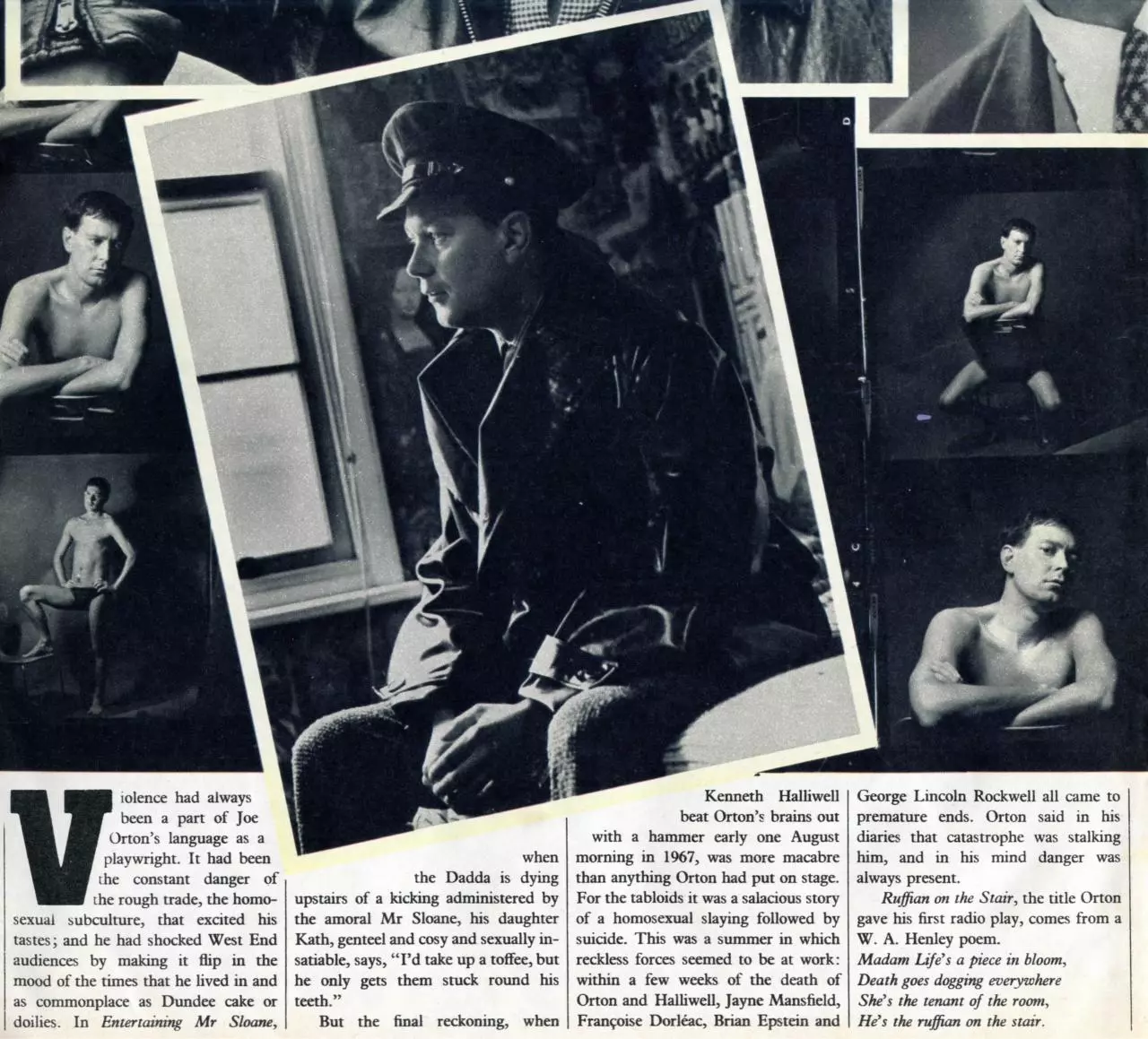The Life & Death of Joe Orton (PDF)
File information
This PDF 1.4 document has been generated by / EPSON Scan, and has been sent on pdf-archive.com on 18/05/2017 at 07:26, from IP address 79.77.x.x.
The current document download page has been viewed 1647 times.
File size: 26.02 MB (19 pages).
Privacy: public file





File preview
HESUNDAY TiMESfnaBitswe
Contents. November 22.1970
O
V*
21 The Piece of Mind which Passeth all Understanding - an examination of telepathy; John Wren-Lewis and Christopher Evans
on Extra-Sensory Perception; the Great Telepathy Test; Dr Ann
Faraday on ESP and psychiatry; James Blish on ESP and Science
Fiction; Tony Osman on ESP in the laboratory; ESP questionnaire.
Cover: aerial photograph by Aerofilms; montage by David King.
!
44 The Life and Death of Joe Orton - the bizarre story of the young
playwright whose work shocked audiences in London and New York
and won praise from critics, and whose own life and death were
as extraordinary as anything he put in his plays; by James Fox.
The life and death of Joe Orton i
his generation, whose anarchism shocked West End audiences but whose brilliant style
Halliwell - below right - had lived together for 15 years. This photograph, with the actor Kenn(
to Morocco when Orton had started to become successful. But it was this sudden success that
depressed and paranoid. He beat Orton to death one morning in 1967 and then killed himself.
M
•j
* » *•** »**
,
Joe Orton, author of Entertaining Mr Shane, Loot and What
the Butler Saw, was one of the most talented playwrights of
le won praise from critics. Orton - below left - and Kenneth
meth Williams in the centre, was taken on one of their expeditions
it broke up the relationship. As he fell behind, Halliwell became
If. Their extraordinary lives are recounted overleaf by James Fox
Orton (right) as a schoolboy in Leicester
V
• HI I iolence had always
fK
^T been a part of Joe
^^B ^f Orton's language as a
^H^V playwright. It had been
• the constant danger of
mfm the rough trade, the homosexual subculture, that excited his
tastes; and he had shocked West End
audiences by making it flip in the
mood of the times that he lived in and
as commonplace as Dundee cake or
doilies. In Entertaining Mr Sloane,
when
the Dadda is dying
upstairs of a kicking administered by
the amoral Mr Sloane, his daughter
Kath, genteel and cosy and sexually insatiable, says, "I'd take up a toffee, but
he only gets them stuck round his
teeth."
But the final reckoning, when
Kenneth Halliwell
beat Orton's brains out
with a hammer early one August
morning in 1967, was more macabre
than anything Orton had put on stage.
For the tabloids it was a salacious story
of a homosexual slaying followed by
suicide. This was a summer in which
reckless forces seemed to be at work:
within a few weeks of the death of
Orton and Halliwell, Jayne Mansfield,
Fran^oise Dorleac, Brian Epstein and
George Lincoln Rockwell all came to
premature ends. Orton said in his
diaries that catastrophe was stalking
him, and in his mind danger was
always present.
Ruffian on the Stair, the title Orton
gave his first radio play, comes from a
W. A. Henley poem.
Madam Life's a piece in bloom.,
Death goes dogging everywhere
She's the tenant of the room,
He's the ruffian on the stair.
The room where it happened with
Orton and Halliwell was an upstairs
flat in Noel Road, Islington, where
they had lived for eight of their 15
years together.
They were a strange couple. Success had come to Joe Orton for only
three out of the 15 years, and even then
it hadn't changed their physical existence, except that at the rare tea parties
they gave later the plates would be
piled high with ABC cakes, Battenburgs,
doughnuts and custard tarts. They had
lived like extremely puritanical hermits, as far as possible outside society.
It was a close homosexual dependence
solidified by years of failure, during
which they were learning, painfully,
how to write. "They read an enormous
amount," says Peggy Ramsay, Orton's
agent, "a lot of Wilde and Firbank and
then they began polishing. It was a
pure attempt to learn your craft which
was very moving. And then Kenneth,
poor dear, tell behind."
He had a long way to fall. Orton's
success was a legend of the Sixties; he
had touched the instant riches of the
decade. When he died, royalties were
beginning to earn him £6000 a year
and the screen rights of Loot had been
sold for a projected £100,000. It was
the kind of success that their relationship couldn't contain. Orton had
become one of the most talented playwrights of his generation; Halliwell
Orton's narcissism started early (top
right). "He was a bird of paradise,"
says his sister Leonie. "He loved to oil
his olive skin, pose for physique
photographs, and dress in leather.11
was a failure, a depressive and an
insomniac.
Orton was outrageous and anarchistic, and as a writer a sharp and
brilliant stylist. He has become a tradition; Ortonesque has become
of classical English comedy.
47
Harold imter t , homage: "I find
his work brilliant and truly original.
As a stylist he's quite remarkable. He
has an instinctive grasp of construction. I don't think anybody has written
like Joe Orton." Frank Marcus,
author of The Killing of Sister George
and a critic who had written about
Orton during his lifetime, says of
What the Butler Saw, Orton's last
play: "I do consider it to be a crucial
play. I think for example it's a much
more profound and serious play than
Chips with Everything or Look Back in
Anger. And I think it will survive and
tell people more about what it felt to be
alive in the Sixties than almost anything else of that period."
ex and violence were
favourite themes of the
Sixties playwrights. Orton
used these ingredients, but
he also used the technique
of farce with uncanny
brilliance.
He was compared to Congreve,
Feydeau and Oscar Wilde. The liberal
Sixties were a natural moment for the
re-emergence of Restoration comedy.
It had resurfaced briefly with Wilde a theatre of organised confusion, of
morals versus manners. Orton was the
natural farceur of an age of violence,
when city life had alienated many from
a common morality.
was a bird of paradise," says his
sister Leonie.
He loved his body and made it
shine with Johnson's baby oil. He
posed for physique photographs. He
had impeccable olive skin, a deep tan
whenever possible and his elfish round
face with its scurrilous darting eyes
was beautiful. Everyone remarked on
Orton's physical beauty and on his
attractiveness as a person. He dressed
in leather, heavy black boots, jeans
and sweatshirts, the uniform of the
trade. And he was a puritan. Orton
and Halliwell never lost the habit of
poverty. Orton was always unable to
spend money and he hated flamboyance and expense, restaurants, drinking, smoking and gambling, although
they were always experimenting with
drugs. They went to bed every night
at 9.30. They continued, even after
they could afford more, to live on
raisins, brown bread and treacle and
baked beans. Joe admired Kenneth
Williams for taking buses. He was horrified when Terence Rattigan suggested he move into Eaton Square.
Peggy Ramsay had to persuade him to
have a telephone because she was
tired of sending telegrams. "I would
say Puritanism is the driving force
behind my work," said Orton in an
interview. "It's a very misunderstood
word, like immoral. When someone
all to be an actor and took elocution
lessons from a woman called Madame.
"I don't know why they called her
Madame. There was nothing Madamish about her at all. She was just an
ordinary, pompous, middle-class lady
and she didn't think much of me. Just
a yob. I could tell that." Madame
organised a show of her pupils to
impress the education authorities.
Orton and a girl pupil did the
quarrel scene of Oberon and Titania
from A Midsummer Night's Dream.
He thought up an outrageous costume.
"I thought I'd play Oberon green, so I
bought a lot of green distemper from
the local shop and put on a pair of
bathing trunks and just covered myself from head to foot in green, including my hair. Surprising I didn't get a
skin rash; then I got a green bedspread from my mother's bed and
wrapped that around me and appeared
on stage in this fantastic outfit while
the girl wore a conventional muslin
ballet dress as Titania." Orton got the
grant and then an audition for RADA,
for which he played Captain Hook and
Smee in Peter Pan simultaneously.
Madame, he said, could hardly conceal
her rage when he was accepted.
National Service would have
wrecked his plans to go to London. So
on the day of the medical examination
he smoked through a packet of cigar-
a formal letter. Next, they sent him
The Mechanical Womb. A note in the
margin on the covering letter says,
"The reductio ad absurdum of the
bug-eyed monster s.f. complete with
mutants, ailing robots and spray guns
and a lot of nonsense kept whirring
around by sheer bewildering speed but
without any claim to character or
design." In 1956 they sent him The
Boy Hairdresser, a camp satire in modern verse. The publisher was intrigued
by this time and invited them for a
drink at a hotel.
jalliwell seemed to be
the dominant partner,"
he said. "He was totally
bald, an egg-like dome.
He looked like the
lyoung Orson Welles.
He had a big jowly chin and talked
with a slightly ponderous voice, whereas Orton in his mid-twenties looked
like a little gamin of about 17, very
good-looking in a slightly urchin way,
very bright, snapping eyes. He had
obviously spent a lot of time sunbathing at the lido. Halliwell was pale. He
wore a beret most of the time. They
invited me to go to the flat and have
supper with them. It was that evening
that I got a glimpse into the life they
led which was the most bizarre and
extraordinary thing I have ever come
across in my life."
Many of his characters came from
Leicester, his home, as if this nylon
town, steeped in gentility, was a compression chamber for a pouring out of
scorn on the whole of humanity. The
city seemed to typify polite restraint
and it was manners like these that
Orton wanted to unfrock. "But unlike
Osborne," says Harold Hobson, "he
was not disturbed by what he found
underneath, he was delighted." Orton
said he found people "profoundly bad,
but irresistibly funny".
Orton fancied himself as Air Sloane.
"I originally saw him as small and
rather stocky," he said. "What many
people have found difficult to understand about Sloane is his innocence
and amorality. The English always
tend to equate innocence with ignorance, which is rubbish." Sloane is a
muscular young thug with a face like a
cherub. Orton was boyish-looking and
amorality was his method of discovery,
of staying as near to the truth about
good and evil as possible. Sloane did
press-ups on tombstones and gave his
favours freely and in innocence. For
Orton's generation of homosexuals
especially, the dangers and the threat
of violence and blackmail encouraged
promiscuity and the cult of brief encounters and Orton frequented public
lavatories and solicited rough trade,
recording every detail in his diaries.
His sexual generosity was unlimited,
his appetite was round. He kept
himself like a prizefighter. "He
says that so-and-so is immoral, he
usually means he goes around seducing
boys or girls, but morals go much
deeper than sexual appetites and real
immorality has little to do with promiscuity. If people had more sex
there might be less real vice in the
world."
He had started with the chest expanders early on, more for his asthma
than his beauty. His mother, a machinist who died six months before him,
sent him to a private technical college
in Leicester after he failed the 11-plus.
His asthma, she thought, would prevent him doing heavy manual work.
John Kingsley Orton (he changed his
name to Joe in 1964) was quiet and shy.
By 15 he had read the whole of Shakespeare, and at the business course
acquired a shorthand speed of 120 and
a typing speed of 60 words a minute.
His father, now in a blind home, was
a gardener, earning £9 a week. "My
mother and father were always having
rows," says Orton's sister. "I can't
say my childhood was happy. There
was always nagging and bickering.
"John lived in his own environment, his own little world. He would
dress himself up as something and
stand in a little stage he'd made with
sheets and then he'd pull the curtains
back and start slobbering something
about Shakespeare."
He joined the Leicester Little
Theatre amateur dramatic group and
played juvenile roles. He wanted above
ettes and ran the two miles to the
examination room, where he was duly
discovered to have chronic asthma and
high blood pressure.
At RADA between 1950 and 1953,
the years of Sylvia Sims and Bernard
Bresslaw, Orton met Halliwell. They
were both lonely.
Halliwell was eight years older than
Orton, a mother-suffocated homosexual, prematurely bald. Both his
parents were dead. He had read a lot
even by that time, and Orton became
his pupil. The entry in Orton's diary
says on successive days: "I said no"
and then "I said yes". With HaUiwell's
money they moved into a flat in West
End Lane, Hampstead. Orton had
given up trying to be an actor after a
six-month period at Ipswich rep. "I
lost my confidence and my virginity,"
he said.
hey began writing.
Their plan was to live
on Halliwell's money
I it ran out, and then
e jobs as labourers until
y had saved enough
money to write again. They made contact with a publisher. "In 1955 I was
sent a short novella called The Last
Days of Sodom by Kenneth Halliwell
and John Orton. A very Firbankian
squib as I remember," says the publisher. "It was set in Sodom before the
wrath of God had descended upon it.
Highly ornamental and artificial. It
revolved around one joke." Hereturned
T
Their two rooms were deeply
gloomy. Halliwell had painted around
the damp patches on the ceiling. To
economise they never used electric
light. They got up when it was light
and went to bed when it got dark.
Their diet consisted of rice, fish and
golden syrup.
In the summer of 1956 they both
took jobs at Cadbury's factory, Orton
as a packer and Halliwell as a clerk.
The publisher invited them to a party.
"First I was genuinely fascinated by
them-they wrote with considerable
wit and style-and secondly I supposed that one day they might write
rather a brilliant piece of work. Halliwell was the creative one and Orton,
although he was always bright and
intelligent, was very much the pretty
boyfriend.
"But my guess is that during these
long periods Orton was educating
himself. He read an awful lot. But he
was not the one I thought would produce anything. His novels were worse
than Halliwell's (at times they had
written separately) and Halliwell supplied the main motive power in their
endeavours."
The party was a disaster. They
arrived with a present: a long cylindrical container of chocolates stolen
from Cadbury's factory and sat side by
side on a sofa, never talking to anyone
and radiating shyness. "I never felt
tempted to repeat the experience,"
said the publisher.
Download The Life & Death of Joe Orton
The Life & Death of Joe Orton.pdf (PDF, 26.02 MB)
Download PDF
Share this file on social networks
Link to this page
Permanent link
Use the permanent link to the download page to share your document on Facebook, Twitter, LinkedIn, or directly with a contact by e-Mail, Messenger, Whatsapp, Line..
Short link
Use the short link to share your document on Twitter or by text message (SMS)
HTML Code
Copy the following HTML code to share your document on a Website or Blog
QR Code to this page

This file has been shared publicly by a user of PDF Archive.
Document ID: 0000598605.